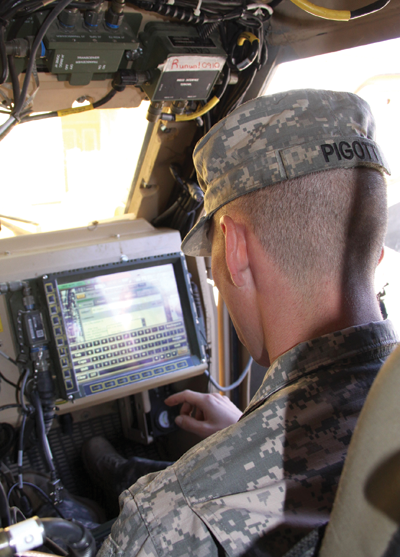Soldiers Shape Next Generation of Army MC System
by Nancy Jones-Bonbrest

A Soldier with the 1st Armored Division evaluates the Joint Battle Command-Platform at a Network Integration Evaluation. (U.S. Army photo)
While deployed to Iraq, SSG Scott Harrison relied on the Army’s chief situational awareness system to plot enemy holdouts, mark known improvised explosive devices, and exchange command and control messages with fellow Soldiers.
Now, his experience is helping shape the next generation of that system — the Joint Battle Command-Platform (JBC-P).
“I think it’s brilliant that they’re using Soldier feedback to develop JBC-P,” said Harrison, who is now assigned to the task analysis branch of the Maneuver Center of Excellence (MCoE) Directorate of Training and Doctrine (DOTD). “I like the idea of getting guys [who] have just deployed and experienced the previous system, and then picking their brains about what changes need to be made.”
Harrison provided feedback on JBC-P during a user jury held earlier this year by the Army’s Training and Doctrine Command Capability Manager (TCM) for Brigade Combat Team Mission Command (BCT MC) at Fort Benning, Ga. The user jury was part of a series of similar events designed to ensure that the evolving capability builds on lessons learned from theater and meets the needs of a digital generation of Soldiers.
“You need the people who are actually going to be using the new capability to verify it,” said SSG Charles Marvel, who is assigned to the 3rd Armored Brigade Combat Team, 3rd Infantry Division. “We’re the ones with our feet on the ground and who see it every day and use it every day.”
Almost 90 Soldiers were polled throughout the three-day user jury. Soldiers used JBC-P in realistic scenarios to send text messages, place calls for medics, and plot enemy strongholds. They then provided feedback on aspects of the system, including user interface, screen size, and graphics.
“We stress quality feedback over quantity,” said Dan Dwyer, senior program integrator for TCM BCT MC. “By putting the systems in front of the warfighter before the capabilities are fielded, it allows us to make the necessary corrections so we ultimately deliver the very best product possible.”
By actively incorporating Soldier feedback, JBC-P, which is assigned to Program Executive Office Command, Control and Communications-Tactical, has evolved to include touch-to-zoom maps, a Google Earth-like interface, and drag-and-drop icons. JBC-P is the Army’s tool for brigade and below mobile mission command, situational awareness, and friendly force tracking, which gives Soldiers a complete picture of the battlefield so units can synchronize operations and reduce fratricide.
JBC-P is the Army’s next-generation upgrade to the Force XXI Battle Command Brigade and Below/Blue Force Tracking system, (FBCB2/BFT). Fielding now is Joint Capabilities Release (JCR), which provides a “bridge” between FBCB2 and JBC-P.
“Receiving feedback on JCR and now JBC-P has been a vital tool in ensuring it is easy for Soldiers to use,” said LTC Michael Olmstead, product manager for JBC-P. “Hearing from Soldiers who have used this capability on the battlefield has been invaluable in improving JBC-P and making it more intuitive.”
Slated for fielding later this fiscal year, JBC-P will continue to incorporate feedback from the user juries as well as from operational evaluations at the Network Integration Evaluations (NIEs).
“Because we have to strategically conduct these user juries in between NIEs, it allows us to get two different flavors of feedback on a frequent basis,” Dwyer said. “We work collectively to ensure that evolving systems such as JBC-P meet the warfighters’ needs by delivering integrated solutions toward the most critical gaps and then validating these capabilities and requirements with the user.”
(Nancy Jones-Bonbrest writes for Project Executive Office Command, Control and Communications-Tactical.)

 Share on Facebook
Share on Facebook email
email print
print